|
From the New York Central Publication — Heath and Pleasure
1893
THE HARLEM DIVISION.
NEW YORK TO CHATHAM.
AT MOTT HAVEN Junction the lines of the Hudson River and the
Harlem Divisions diverge, the former curving westward to the Hudson
River, the latter continuing due north.
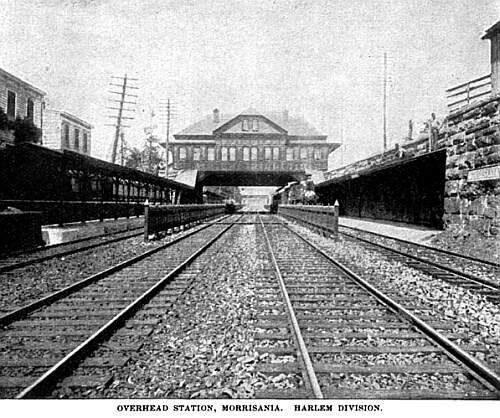 The extensive
improvements affecting the entire line north of the Harlem River,
within the city limits — a distance of seven miles —
have been completed and mark a successful termination of an undertaking
of vast importance, involving the lowering of the surface of the
old road-bed below the street level and carrying the streets over
the track, thus avoiding grade crossings. The new road-bed contains
four tracks laid with heavy steel rails upon standard ties and
eighteen inches of broken stone ballast. The two central tracks
are for the exclusive use of through express trains, and the two
outer tracks accommodate the local or rapid transit trains. The
track has been depressed an average of eight feet below its former
level, the grade of the adjoining streets being raised eight to
fourteen feet. The excavation is lined with cut stone masonry
walls. Twenty-one of the city streets which formerly crossed the
track at grade are carried over the four tracks by iron bridges,
of the full width of the road-ways and sidewalks, and five of
the old station buildings have been replaced by handsome iron
structures, of much architectural beauty, built over the track,
on the same level and in connection with the adjacent bridges
which form the approaches to these stations. The length of the
new station buildings is sixty-nine feet across the track, the
width twenty-six feet. Each accommodates a ticket office, waiting,
rooms, ladies' retiring rooms, two baggage lifts for handling
baggage, and two stairways descending to the platforms at the
tracks on either side for "up" and "down"
trains. The platforms are 500 feet in length and ten feet wide.
The cost of these improvements was in the neighborhood of $2,000,000. The extensive
improvements affecting the entire line north of the Harlem River,
within the city limits — a distance of seven miles —
have been completed and mark a successful termination of an undertaking
of vast importance, involving the lowering of the surface of the
old road-bed below the street level and carrying the streets over
the track, thus avoiding grade crossings. The new road-bed contains
four tracks laid with heavy steel rails upon standard ties and
eighteen inches of broken stone ballast. The two central tracks
are for the exclusive use of through express trains, and the two
outer tracks accommodate the local or rapid transit trains. The
track has been depressed an average of eight feet below its former
level, the grade of the adjoining streets being raised eight to
fourteen feet. The excavation is lined with cut stone masonry
walls. Twenty-one of the city streets which formerly crossed the
track at grade are carried over the four tracks by iron bridges,
of the full width of the road-ways and sidewalks, and five of
the old station buildings have been replaced by handsome iron
structures, of much architectural beauty, built over the track,
on the same level and in connection with the adjacent bridges
which form the approaches to these stations. The length of the
new station buildings is sixty-nine feet across the track, the
width twenty-six feet. Each accommodates a ticket office, waiting,
rooms, ladies' retiring rooms, two baggage lifts for handling
baggage, and two stairways descending to the platforms at the
tracks on either side for "up" and "down"
trains. The platforms are 500 feet in length and ten feet wide.
The cost of these improvements was in the neighborhood of $2,000,000.
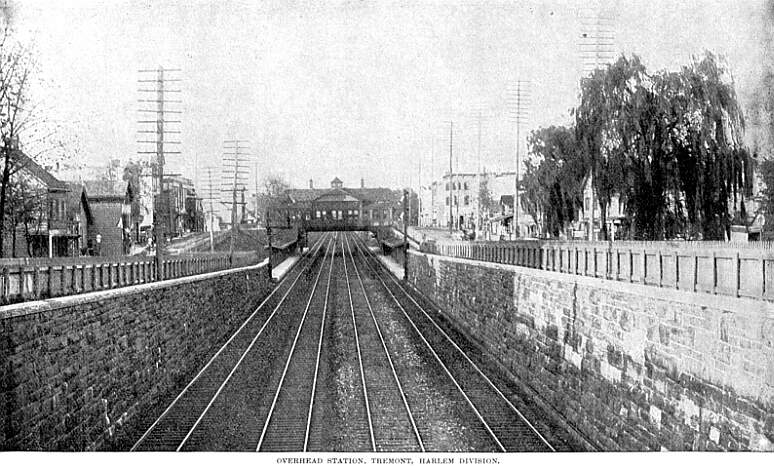
Continuing our way, we pass through Melrose, Morrisania and
Tremont, all handsome suburbs of the city, which have been so
rapidly settled within the past few years that their identity
is all but merged in that of the great metropolis. In nine miles
we reach
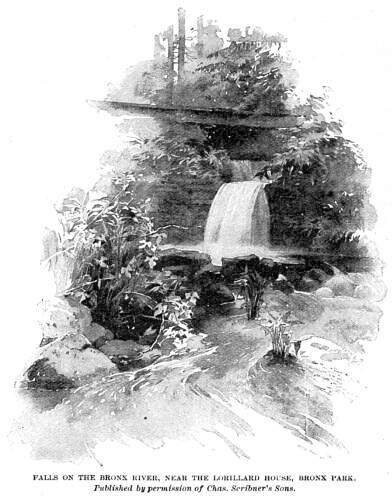 FORDHAM. FORDHAM.
Fordham, the seat of St. John's College, a noted Roman
Catholic institution, whose buildings and spacious grounds are
seen to the right of the track. The popularity of Fordham as a
place of residence is attested by the large number of tasteful
houses built within the last few years, as well as the number
now in course of erection. There is an excellent public school
here, a number of good stores and several churches. The next station
is
BEDFORD PARK.
Bedford Park, a beautiful and rapidly growing place,
and the residence of a number of well known New Yorkers, whose
tasteful villas embellish the broad and handsome avenues of the
Park. Opposite the station is the site of the new Bronx Park.
The New York Herald recently published a highly interesting
article relative to the proposed establishment of a botanical
garden, museum and arboretum, fashioned somewhat on the plan of
the magnificent Kew Gardens of London, at Bronx Park, from which
the following is abstracted:
"I suppose there are thousands and thousands and even
hundreds of thousands of New Yorkers who have never been in Bronx
Park, and have no idea how to get there. This magnificent breathing
spot of the future millions of the men and women of the Manhattan
of the next generation, however, is hardly a half hour distant
from the Forty-second Street Station. You descend from the train
at Bedford Park Station and the 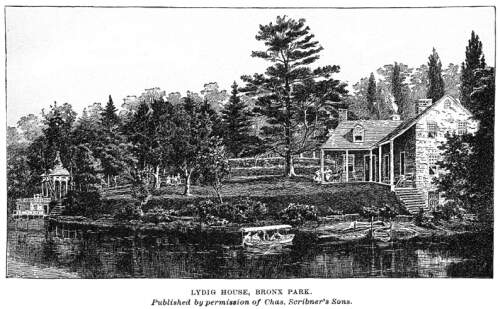 beautiful vistas of the Bronx
Park open out before your astonished gaze. I have been in the
remoter regions of the Yellowstone National Park and have
seen nothing more attractive than the varied sylvan land and water-scape
scenery of this attractive resort, which is not resorted to even
in Summer by the great masses of the population because attention
has never been drawn to its wonders. Were it not for a very occasional
park policeman jogging by in his Confederate gray, it requires
no effort of the imagination to locate yourself in Sherwood Forest
or in any other sylvan scene which may attract your fancy. The
park is about 800 acres in extent, lying in the 23d and 24th wards
of New York City and Westchester County. All that portion of the
park north of the Bronx River is in Westchester. beautiful vistas of the Bronx
Park open out before your astonished gaze. I have been in the
remoter regions of the Yellowstone National Park and have
seen nothing more attractive than the varied sylvan land and water-scape
scenery of this attractive resort, which is not resorted to even
in Summer by the great masses of the population because attention
has never been drawn to its wonders. Were it not for a very occasional
park policeman jogging by in his Confederate gray, it requires
no effort of the imagination to locate yourself in Sherwood Forest
or in any other sylvan scene which may attract your fancy. The
park is about 800 acres in extent, lying in the 23d and 24th wards
of New York City and Westchester County. All that portion of the
park north of the Bronx River is in Westchester.
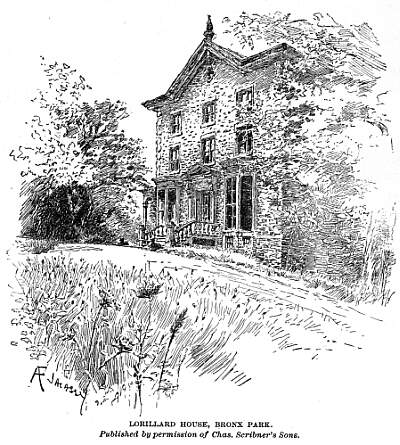 "The park was purchased in 1884 for
$3,000,000, from the estate of the late Peter Lorillard and several
other property owners. Since then the Department of Parks has
been allowed only $20,000 annually for the keeping in repair and
improving of Bronx, Pelham and Van Cortlandt Parks and the four
other parks which were acquired almost at the same time by the
department on the northern confines of the city. An insignificant
sum with which really wonders have been accomplished. "The park was purchased in 1884 for
$3,000,000, from the estate of the late Peter Lorillard and several
other property owners. Since then the Department of Parks has
been allowed only $20,000 annually for the keeping in repair and
improving of Bronx, Pelham and Van Cortlandt Parks and the four
other parks which were acquired almost at the same time by the
department on the northern confines of the city. An insignificant
sum with which really wonders have been accomplished.
"Bronx Park, however, it must be said, came into the possession
of the city in a magnificent condition. For the most part it was
the country residence of the late Peter Lorillard, and along the
north side of the Bronx are still to be seen the ruins of the
Lorillard snuff mills, which the beautifying if destructive touch
of time has made most picturesque.
"Along this woodland stream, which now glides with a contented
murmur through mossy banks, now with tempestuous roar through
great granite walls, beautifully shaded throughout its course,
from Williams Bridge to the Sound, with umbrageous oaks and hemlocks,
spruce, maple and pine, was the favorite walk of the Maryland
poet—Edgar Allen Poe—during the many years he lived
in the Fordham cottage, some ten minutes' walk away. And it seemed
to me that, as I walked along this lovely stream, I recognized
here a glade, there a vale, and now a water vista which must have
inspired the poet's pen as he painted, as perhaps only Ruskin
since his day has painted, the beauties of woodland scenery in
his "Magic Garden."Beautiful as Twickenham is, fair
and lovely as is the peaceful scene that is beheld from Richmond
Heights, the surroundings of the embryo botanical garden are a
hundred times more beautiful than the country about Kew with the
poet's praised Copper's Hill in view. May the garden be worthy
of its magnificent scenic setting!
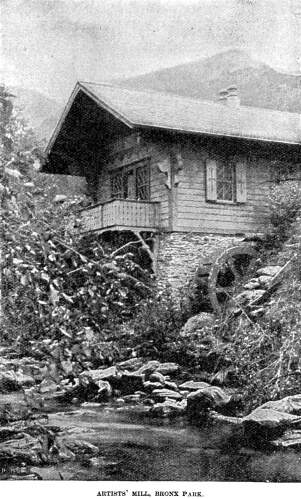 "On a wooded plateau above the river,
just behind the snuff mills, where still hangs the weather-beaten,
worm-eaten sign of Peter Lorillard, is the proposed site of the
Botanical Garden. The Bronx River furnishes an abundance of water,
there is a plenty of protective timber, the soil is fertile, and
there is both low and high lying land—in fact, an ideal site,
and it is to be hoped that the Legislature making the foundations
broad and deep, wealthy lovers of the flowers of the field will
before the next spring has come begin the erection of a building
at which New Yorkers may point with pride, and in which thousands
and thousands who otherwise would never see a natural flower,
of even our own flora, may behold the variegated, fragrant plants
that the sun beholds in every world and in every clime in its
daily course, and profit by this elevating and educating sight." "On a wooded plateau above the river,
just behind the snuff mills, where still hangs the weather-beaten,
worm-eaten sign of Peter Lorillard, is the proposed site of the
Botanical Garden. The Bronx River furnishes an abundance of water,
there is a plenty of protective timber, the soil is fertile, and
there is both low and high lying land—in fact, an ideal site,
and it is to be hoped that the Legislature making the foundations
broad and deep, wealthy lovers of the flowers of the field will
before the next spring has come begin the erection of a building
at which New Yorkers may point with pride, and in which thousands
and thousands who otherwise would never see a natural flower,
of even our own flora, may behold the variegated, fragrant plants
that the sun beholds in every world and in every clime in its
daily course, and profit by this elevating and educating sight."
WILLIAMS BRIDGE.
Williams Bridge, eleven miles from New York, is a very
attractive place, and shows year by year a healthful and natural
growth in population and land values. A handsome new station with
attractive exterior and commodious waiting rooms and baggage rooms,
and a tasteful lawn at the rear has recently been erected here.
One mile beyond is
WOODLAWN.
Woodlawn, where is located the largest and most beautiful
of the many cemeteries in the vicinity of New York. The cemetery,
however, is not Woodlawn's only claim to distinction. Crowning
the hills north and east of the station are many handsome cottages
occupied by the families of New York business men who have made
the discovery that no locality in the vicinity of the city offers
better inducements for residence. The elevation is sufficient
to dispel any idea of malaria, the drainage perfect, the surroundings
delightful. Also, Woodlawn enjoys with one or two exceptions the
most ample train service of any station on the line.
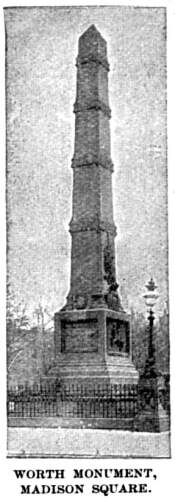 MOUNT VERNON. MOUNT VERNON.
Mount Vernon, thirteen miles from New York, is now
a full fledged city, offering inducements for residence which
are scarcely equalled by any other place in the vicinity of the
metropolis. It has a population of about 15,000. The city is attractively
laid out, and contains many fine churches and schools, and also
a large number of elegant and tasteful dwellings. The streets
are broad and generally well paved, lighted and sewered. The houses
are for the most part surrounded by gardens or terraced lawns.
A line of horse-cars crossing the town meets all trains, of the
Harlem Road. The growth of Mount Vernon within the past few years
has been very rapid, and the march of progress tends steadily
onward.
BRONXVILLE.
Bronxville, the next stopping place, is set in the
midst of exceptionally beautiful surroundings, and the visitor
notices everywhere evidences of healthful growth and enterprise.
Armour Villa Park, on a pretty hillside to the left of the track,
within three minutes' walk of the Bronxville station, is one of
the most beautiful and tasteful collections of villas in Westchester
County. The park has been laid out with pretty lawns and broad
avenues of dazzling whiteness spread with broken marble from the
famous quarries at Tuckahoe. Distant views of the Palisades, villas
and cottages surrounded by fine trees, and miles upon miles of
forest growth, stretching out towards the Harlem and the Hudson,
make a charming picture. Opposite Bronxville is Lawrence Park,
with many of the characteristics of Armour Villa.
TUCKAHOE.
Tuckahoe, sixteen miles from New York, is famed for
its extensive marble quarries, whose product is shipped to all
parts of the United States. It is a handsome town of about 1,700
inhabitants, and now more than ever before seems animated by the
genius of improvement. To meet the demand for building sites several
old country seats have been put on the market, and building is
rapidly progressing. Seven hundred yards from the station is Mohegan
Park, which boasts a location unsurpassed for beauty and healthfulness.
Looking toward the west may be seen the Palisades of the Hudson
and on the east the waters of the Sound. The foothills of the
Berkshires are visible at the north, and the towers and spires
of New York City at the south. The soil is dry and sandy and the
natural drainage perfect. The water supply is from an artesian
well, and is the best and purest that can be obtained.
It is proposed to make Mohegan Park an ideal place for suburban
homes, and no pains or expense will be spared in laying out and
beautifying its public grounds and drives.
VICTORIA PARK.
Victoria Park, the imposing entrance to which is
seen just over the hill to the left of the station, comprises
about 70 acres, situated in the city of Yonkers, of which it forms
part of the Fourth Ward. The property consists of fine level meadowland,
slightly sloping to the west, thus assuring perfect drainage;
the soil is a fertile sandy loam. Improvements are being pushed
with energy, and a number of handsome houses have already been
erected; this season will doubtless see many others under way.
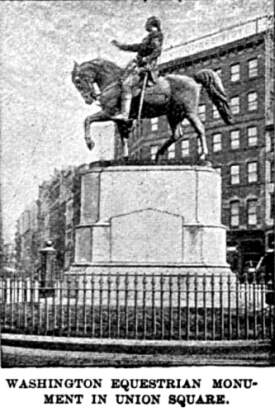 YONKERS
PARK. YONKERS
PARK.
Yonkers Park, adjoining Tuckahoe, also located
in the Fourth Ward of Yonkers, is situated on high ground, and
is rapidly developing. Extensive improvements have already been
made, and more are promised. Streets and drives of generous width
have been not only laid out, but they are opened, graded, curbed
and flagged. Handsome entrances have been constructed at the approaches
to the main avenue, and landscape gardeners and architects are
actively employed in beautifying the spot. Three miles north of
Tuckahoe is the pretty village of
SCARSDALE.
Scarsdale, which offers special inducements to those
in search of a healthful and quiet country home. The broad acres
of the old Arthur Manor have been purchased by a syndicate of
capitalists, who are rapidly prosecuting the work of grading,
opening streets and avenues and marking out corner lots. Investors
will do well to look the ground over at Scarsdale before deciding
upon another location. Less than two miles beyond is
HARTSDALE.
Hartsdale, another attractive Westchester village,
containing several Summer boarding houses. Passing Hartsdale we
enter a very pretty stretch of country, with rolling hills to
the right and left, and skirting the track the silvery Bronx,
now broader and deeper than where we left it a few miles below,
and wearing more the aspect of a river. Crossing a substantial
iron bridge and sweeping around a grand curve we enter
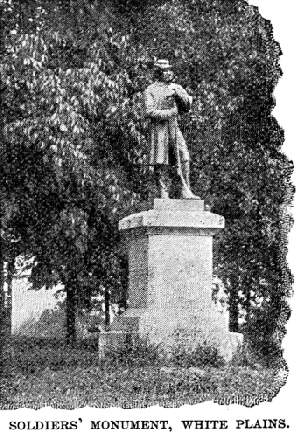 WHITE PLAINS. WHITE PLAINS.
White Plains, the capital of Westchester County, 22
miles from New York, and one of the finest towns on the road.
The history of White Plains antedates the Revolution, and is full
of interest. In 1663, more than two centuries ago, English settlers
from Greenwich, Conn., purchased from the Indians a tract of ground
called Quaroppas, or, as they named it, "The White Plains."
The title was disputed, however, and the dispute operated to prevent
a settlement of the Plains until about 1720. In 1721 certain persons
living in what we now call White Plains obtained for themselves
a grant from the British Government of 4,435 acres, and divided
the land. Among the owners we find the well-known town names of
Underhill, Hatfield, Horton and Brown.
On the 28th of October, 1776, the battle of White Plains was
fought, the principal and decisive part of the engagement being
at Chatterton Hill, a little to the west of the railroad and across
the Bronx River. Washington, who was personally in command, made
his headquarters just north of the town, about one mile from the
railroad station. The principal street is about a mile long, very
wide, and being thickly shaded, forms an attractive feature of
the town. It was given to the village by George III. White Plains
is especially distinguished for its healthfulness. This fact,
with its accessibility, makes it very desirable to many persons
for Summer homes. New water works have been recently constructed,
and the village is now favored with as good a system of water
supply as can be found anywhere.
HAWTHORN BEACH. RYE BEACH. MILTON
POINT.
About six miles distant, on the Sound Shore, are Hawthorn
Beach, Rye Beach, Milton Point, and other attractive resorts that
afford excellent fishing and bathing. All of these points are
reached by one or another of the beautiful drives for which Westchester
County is noted. Proceeding northward from White Plains a charming
landscape reveals itself in varied manifestations of wondrous
beauty. Rare combinations of mountain, stream and foliage greet
the eye in endless variety, the whole forming a panorama of rural
scenery incomparable for beauty, picturesqueness and variety.
A run of three miles brings us to
KENSICO.
Kensico, one of the most charming villages on the line.
Lake Kensico, of which a fleeting glimpse is obtained as the train
enters the station, is bosomed in the hills that rise directly
in back of the village. It is two miles long and about half a
mile wide. Fronting and overlooking the lake is beautiful Kensico
Park, which is being very tastefully laid out, and will soon be
the center of a large permanent population. North of the station
for some distance, and extending on both sides of the track, is
the New Amsterdam Park, where the process of development has only
just begun. About 100 rods north on a slope to the west of the
track is the handsome new station of Kensico Cemetery.
UNIONVILLE.
Unionville, the next station beyond, is most delightfully
situated and offers many inducements, either for permanent residence,
or a temporary Summer home. The country is quite hilly, and lakes
and streams abound. Buttermilk Hill, said to be the highest point
of land in Westchester County, overlooks the village on the west.
From its summit are obtained fine views of the Hudson Highlands,
the Statue of Liberty in New York Bay and the spires of St. Patrick's
Cathedral, Sherman Park, one of the most popular, healthful and
picturesque suburban home sites on the line, begins about half
a mile south of Unionville, east of and adjoining the railroad
property, and extends north as far as Pleasantville. A handsome
new station for the Park has been erected about midway between
Unionville and Pleasantville, and arrangements have been made
to stop a number of important trains there for the accommodation
of Park residents. Streets have already been opened, avenues laid
out, and a large number of attractive houses erected.
PLEASANTVILLE.
Pleasantville, 31 miles from New York, has improved
very rapidly during the past year, from 15 to 25 houses having
been erected within that time. Good board can be obtained here
for the Summer, and a more desirable spot it would be difficult
to find. Two miles further on is
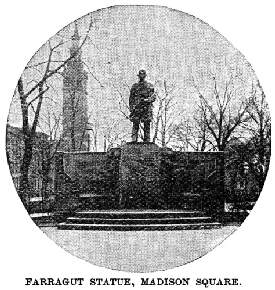 CHAPPAQUA. CHAPPAQUA.
Chappaqua, where Horace Greeley lived and learned what
he knew about farming. Unique and aboriginal as the name is, there
are many who think the place should have been named Pleasant Valley,
for surrounding hills never bosomed it pleasanter. So thoroughly
was it drained by the late Mr. Greeley—who spent the happiest
hours of his life upon its meadows and hillsides—that malarial
diseases never invade its quiet dwellings. The unpretentious but
tasteful house that was Mr. Greeley's home, was totally destroyed
by fire a few years ago, and his daughter now occupies what was
formerly the old stone barn, but has been transformed by a skillful
architect into it handsome and commodious residence. The forest,
where for more than 20 years Mr. Greeley's axe taught the sapling
how to mature into the well-shaped and graceful tree, is still
the resort of the meditative and the gay. All about Chappaqua
are charming groves and rocky dells, and dotting the hillsides
many sightly and comfortable homes which invite the weary denizen
of the great city to spend, at reasonable cost, the Summer hours
which custom permits him to withdraw from the counting-room or
workshop.
CHAPPAQUA MOUNTAIN INSTITUTE.
The Chappaqua Mountain Institute, known as the
"seat of Quaker learning," is situated here, and its
ample grounds and buildings are thrown open during the Summer
vacation to guests who may wish to occupy its comfortable and
airy rooms. Here, too, is the old Quaker Church, once occupied
by sick and wounded soldiers of the Revolution, and on the surrounding
slopes lie the bones of many a hero who fought and died for liberty.
There are two good hotels and several desirable boarding places
in the village, and the drives are interesting and numerous. Resuming
our journey, an entertaining ride of about four miles brings us
to
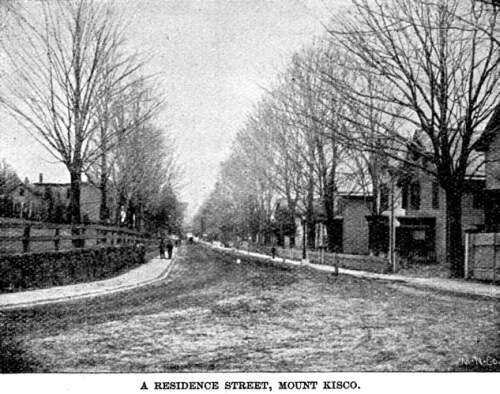 MOUNT
KISCO. MOUNT
KISCO.
Mount Kisco, an interesting and thriving place of 1,500
population, 37 miles from New York. Like most of the towns of
Westchester and other counties lying on the east bank of the Hudson,
Mount Kisco is favored with charming drives, freshened by fragrant
groves and rippling rills, affording many and various glimpses
of a landscape charming in the extreme. Situated at a considerable
altitude above the sea level, Mount Kisco enjoys a pure, brisk
air, and rarely beautiful natural environments.
Like a jewel in its setting, the village nestles amid wooded
hills, charming valleys and limpid streams, surrounded on all
sides by an ever-changing and increasingly fascinating landscape.
A network of country roads, everywhere presenting views that charm
the eye, spreads in all directions, affording a never ending combination
of drives whose attractiveness is not soon exhausted. Sharp turns
around the bases of steep hills, now wending through a deep ravine,
then at the very edge of a precipice, give a variety of views
that is really kaleidoscopic.
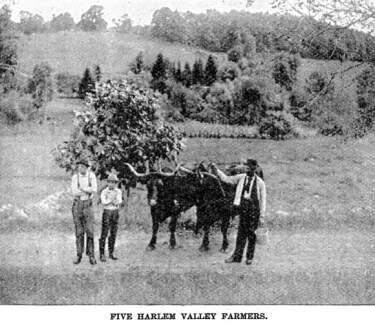 A short drive over a picturesque road in
a northeasterly direction brings the sight-seer to Croton Lake,
a beautiful body of pure drinking water for the denizens of the
great metropolis. Here is good fishing, and on both sides excellent
driveways, while at a little distance back green hills present
their irregular outlines against the sky. Two miles farther one
is brought face to face with one of the mightiest engineering
feats in all ages—the new Croton Aqueduct—which cannot
fail to well repay even repeated visits. Just west of the village
flows the quiet Kisco, from which the place derives its name (meaning
"still water"), and in every direction are streams of
more or less magnitude, while springs of pure, sparkling cold
water are almost as numerous as wells. At the northwestern limits
of the village looms up old Kisco Mountain, like a sentinel over
the settlement. Since its incorporation, twelve years ago, a wise
administration of village affairs, backed by a commendable degree
of public spirit, has done much for the place. There the over
three miles of village streets with stone side-walks, well laid
and in good repair. The houses are of tasteful design, and their
surroundings are neat and attractive. Numerous grocery, dry goods
and hardware stores, and meat and vegetable markets, furnish all
needed family supplies most conveniently. The churches are all
in a thriving, harmonious condition, and the pastors men of ability
and earnestness not usually found in a village of this size. The
Presbyterians, Methodist Episcopal, Catholic, Protestant Episcopal,
and Friends denominations have commodious places of worship, all
in good repair, and not burdened with the customary heavy debts.
The Union Free School is justly a matter of village pride, and
is rarely surpassed in excellence even in towns much larger. The
non-resident attendance at this school is large, and is steadily
increasing. A short drive over a picturesque road in
a northeasterly direction brings the sight-seer to Croton Lake,
a beautiful body of pure drinking water for the denizens of the
great metropolis. Here is good fishing, and on both sides excellent
driveways, while at a little distance back green hills present
their irregular outlines against the sky. Two miles farther one
is brought face to face with one of the mightiest engineering
feats in all ages—the new Croton Aqueduct—which cannot
fail to well repay even repeated visits. Just west of the village
flows the quiet Kisco, from which the place derives its name (meaning
"still water"), and in every direction are streams of
more or less magnitude, while springs of pure, sparkling cold
water are almost as numerous as wells. At the northwestern limits
of the village looms up old Kisco Mountain, like a sentinel over
the settlement. Since its incorporation, twelve years ago, a wise
administration of village affairs, backed by a commendable degree
of public spirit, has done much for the place. There the over
three miles of village streets with stone side-walks, well laid
and in good repair. The houses are of tasteful design, and their
surroundings are neat and attractive. Numerous grocery, dry goods
and hardware stores, and meat and vegetable markets, furnish all
needed family supplies most conveniently. The churches are all
in a thriving, harmonious condition, and the pastors men of ability
and earnestness not usually found in a village of this size. The
Presbyterians, Methodist Episcopal, Catholic, Protestant Episcopal,
and Friends denominations have commodious places of worship, all
in good repair, and not burdened with the customary heavy debts.
The Union Free School is justly a matter of village pride, and
is rarely surpassed in excellence even in towns much larger. The
non-resident attendance at this school is large, and is steadily
increasing.
But all these considerations of attractiveness fade before
that superlatively important one—healthfulness. And in this
respect Mount Kisco again comes forward with an extraordinary
and clean record of carefully kept statistics, showing the average
death rate to the entire population to be ten to 1,000, comparing
most favorably and strikingly with the New York City mortality
statistics of one to 40, and proving Mount Kisco to be more than
twice as healthy as the great metropolis. A syndicate of capitalists
recently formed has purchased a vast tract of land here which
it is proposed to transform into a park similar to Tuxedo, with
fish and game preserves, race-course, etc., and to construct a
handsome club-house and cottages which shall be the pride of the
country side. After leaving Mount Kisco, the next application
of air-brakes brings us to a standstill at
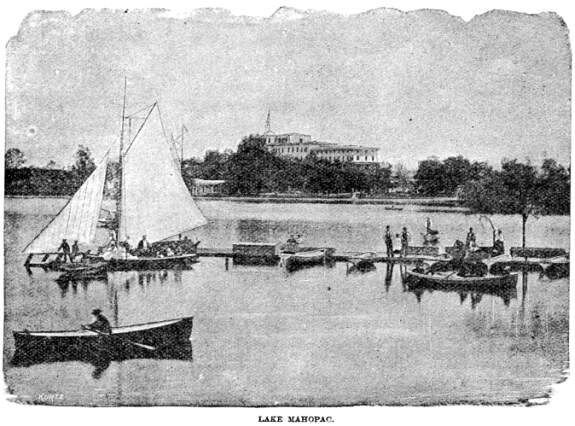 BEDFORD. BEDFORD.
Bedford, 39 miles from New York City. Bedford is a
beautiful village situated at the base of a rocky eminence, in
one of the most romantic and picturesque parts of Westchester
County. The drives and rambles through and along the valley in
which this town is situated, and over the surrounding slopes and
hills, are the most charming to be met with in this section of
the country.
Lying about one mile to the northwest is Croton Lake, studded
with green islands, and hemmed in with bold and rocky shores;
it abounds with fish of the most gamy sort, offering fine sport
to the angler; its waters are frequented by all kinds of water
fowl, including black and canvas-back ducks.
The natural drainage of this village is perfect. There are
no miasmic swamps hereabout; the water is the most wholesome to
be met with in nature, and intermittent fever is unknown here.
A line of stages connects this village with the historic village
of the same name, situated about four miles distant, once a half-stone
town, and destroyed by Tarleton and his rangers during the Revolution.
The town is also supplied with a line of stores, among the best
to be met with along the entire road; in addition, a first-class
hotel and livery stable. A large number of the most inviting private
boarding houses for Summer boarders are located in this vicinity
to meet the demands of those wishing to avail themselves of the
advantages offered by this beautiful hamlet. Speeding on, we soon
come to a stop at
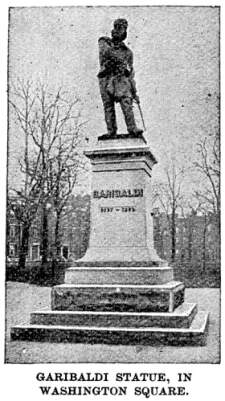 KATONAH. KATONAH.
Katonah, a romantic village named after an Indian chief,
who originally owned all the land hereabout, a large tract of
which was secured by the Jay family, who for generations past
have made it their home. Katonah is 42 miles from New York, has
a population of about 700, and is situated near the boundary line
between Westchester and Putnam Counties. It is noted for its hills
and valleys, pure water and bracing air. The extensive traveler
will, now and then, find a place where those who become accustomed
to its scenery and general surroundings seldom migrate, and contentedly
live on to a good old age, when the homestead is handed down to
the next generation. Katonah is such a place. A beautiful stream
of pure, clear water runs through the village, formed by two branches
of the Cross River and the Beaver Dam, the former finding its
origin in Lake
Waccabuc, and the latter in Woodland Springs. Both streams
abound in trout. The "whirr" of the partridge, the whistle
of the quail, the bark of the gray squirrel, as well as of the
thieving fox in the poultry yard, remind one that it is "country,"
and all afford fine sport when the "law is off." The
town is fully up to its rural surroundings, and the enterprise
of residents may have carried it a little beyond. It has two fine
churches, a village improvement society, composed of its most
eminent citizens, who have provided many conveniences and luxuries,
including sidewalks, shade trees and street lamps. There is also
a commodious reading-room, with an extensive library, largely
sustained and patronized by Hon. John Jay, Hon. William H. Robertson
and Hon. Henry E. Pellew. There are two stage lines in operation
from Katonah; one runs to Boutonville, nine and a half miles,
stopping en route at Cross River and South Salem; another
runs to Lake Waccabuc, seven miles. The railroad company has set
apart a piece of ground along the platform at the station, which
is beautifully laid out with flowers during the Summer. A ride
of two miles farther brings us to
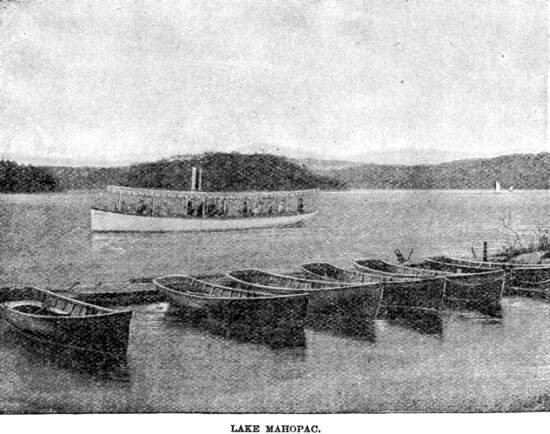 GOLDEN'S BRIDGE. GOLDEN'S BRIDGE.
Golden's Bridge. This quaint little place, 44 miles
from New York, may very justly feel a natural pride in its surroundings.
About four miles to the east of the bridge, at the terminus of
a drive or walk that presents a constant succession of charming
surprises of nature, we find little
LAKE WACCABUC.
Lake Waccabuc, smiling back at the sun, or timidly hiding
its ripples in the long shadows of high, overhanging foliage.
Like all the lakes in this section, Lake Waccabuc is well stocked
with the choicest variety of fish.
Twenty years ago the tourist wishing to visit this section
of Westchester County could not do so in comfort. The luxury of
comfortably equipped cars was wanting after White Plains was reached,
and one of the old style four-in-hand coaches was substituted
for the remainder of the trip. But now things are different. A
short ride on the Harlem Railroad to Golden's Bridge, and a drive
or walk of a few miles over the country eastward, brings him to
Waccabuc Lakes. As he rides along he sees some of the innumerable
biding places of the cowboys of a hundred years ago—the "bummers"
of the Revolution. A couple of Washington's headquarters are reached,
and after winding through a beautiful wood the three lakes of
Waccabuc suddenly lie beneath you, strung like glittering jewels
on a stream which is so shaded by overhanging boughs that the
sun never reaches its waters. These lakes are located among the
hills for which Westchester County is justly noted, and are remarkably
picturesque. The city authorities of New York have deepened the
channels which connect them, so as to have a free flow of water
into the last lake, which flows into Croton River near by. The
passages between the lakes are from half a mile to a mile in length,
through the woods, and each lake is from four to six miles in
circumference. Choice varieties of fish are plentiful, and the
country abounds with small game, furnishing ample recreation for
sportsman and angler.
The country is rich with stories of red-coats and Indians,
and many traces of the latter are still to be seen. In the center
of the lake is the little island of Juan Fernandez, with its curious
Indian ovens, and a little beyond it is the Cedar Grove, a small
hill, beautifully shaded, and almost surrounded by water—a
spot deservedly popular with picnicing tourists as well as rustic
swains and sweethearts.
At Golden's Bridge we take the Lake Mahopac branch of the Harlem
Railroad, and ascending a grade of 85 feet to the mile, for seven
miles, we reach one of the most Eden-like spots on the face of
the globe
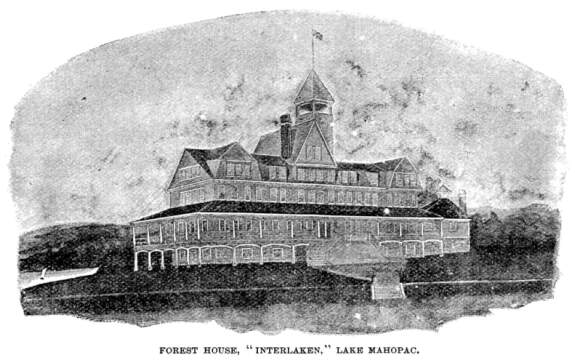 LAKE
MAHOPAC. LAKE
MAHOPAC.
Lake Mahopac. The Harlem Road has recently constructed here a
handsome, new station of the Queen Anne style, containing a spacious
waiting room, ticket and telegraph offices and a covered platform
12 feet wide and 200 feet long. It is located at the junction
of the Peekskill and Cross roads, and distant about 300 feet from
the water line of the lake.
This locality has long been known as a charming Summer retreat,
and improved facilities now furnished by the Harlem Railroad for
reaching it, the ample accommodations provided by the excellent
hotels and neighboring farm houses, make it more accessible and
popular than ever before. The lake, which has an elevation of
nearly 1,000 feet above the sea, although but a few miles therefrom,
covers an area of 700 acres, interspersed with lovely islets,
and abounding in such rare fish as black bass, white and yellow
perch, pickerel, etc. Mosquitoes are unknown here, and boating,
which at all times is an attractive feature at Lake Mahopac, is
by moonlight a reminder of fairyland, The charm of its scenery;
its unsurpassed drives, including the grand boulevard, which entirely
encircles the lake, nine miles; its healthful atmosphere, the
variety of pastimes to be enjoyed, free from unpleasant surroundings,
together with the superior accommodations to be obtained at reasonable
rates, make Lake Mahopac a place of resort that has few equals.
The principal hotels are Thompson's, beautifully situated on
the shore of the lake, and with accommodations for about 400 guests,
and the Dean House, accommodating about 150, and the new Forest
House at Interlaken.
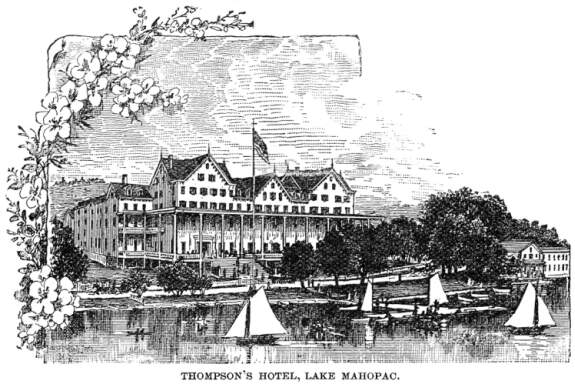 Lakes Waccabuc,
Oscawana and Peach, each with its own special charm, are all within
easy driving distance. Situated in the midst of so much that is
interesting, it is not surprising that the prettiest little lake
in our State should every Summer attract crowds of visitors from
near and far. A line of stages runs daily between Lake Mahopac
and Peekskill, 14 miles, stopping at Mahopac Falls, Jefferson
Valley, Shrub Oak and Lake Mohegan. Situated about midway between
Golden's Bridge and Lake Mahopac, on the Lake Mahopac Branch of
the Harlem Railroad, we find the quiet little hamlet of Lakes Waccabuc,
Oscawana and Peach, each with its own special charm, are all within
easy driving distance. Situated in the midst of so much that is
interesting, it is not surprising that the prettiest little lake
in our State should every Summer attract crowds of visitors from
near and far. A line of stages runs daily between Lake Mahopac
and Peekskill, 14 miles, stopping at Mahopac Falls, Jefferson
Valley, Shrub Oak and Lake Mohegan. Situated about midway between
Golden's Bridge and Lake Mahopac, on the Lake Mahopac Branch of
the Harlem Railroad, we find the quiet little hamlet of
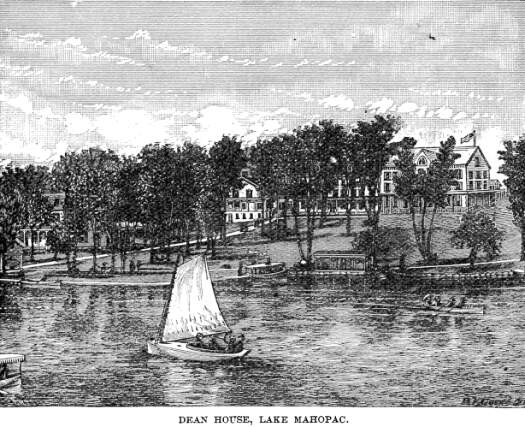 SOMER'S CENTRE. SOMER'S CENTRE.
Somer's Centre, whose every appearance bespeaks comfort,
content and health. It has an elevation of 1,000 feet above the
sea, and is entirely free from all malarial influences. The surrounding
country is mountainous in character, charmingly clothed with verdure,
and liberally supplied with game, both aerial and aquatic, there
being four lakes (including Lake Mahopac) within a radius of three
miles. The history of Somer's Centre is full of interest, and
on every hand can be seen mementos of the Revolutionary days.
The oldest Methodist Episcopal church in America is situated here,
and has held continuous service from Sabbath to Sabbath since
the year 1790. The drives about the surrounding country are all
that can be desired, and the accommodations for Summer boarders
are exceedingly good and liberal. Returning to Golden's Bridge,
we resume our journey on the main line, and, after passing through
Purdy's and Croton Falls, we enter Putnam County, and stop at
BREWSTER.
Brewster, an enterprising and growing village, 52 miles
from New York, with a population of nearly 2,500. Connections
are made here in Union Station with the New York & New England
Railroad for Danbury, Waterbury, Hartford, Willimantic, etc. The
surrounding country is rich in farms, iron mines, delightful drives,
lakes well stocked with fish, and historical reminiscences, while
its healthfulness is established beyond question by such evidences
as the absence of malarial influences, and the long and contented
lives of its happy inhabitants. Among the farms worthy of notice
may be mentioned the broad acres once tilled by the late Daniel
Drew, now occupied by his only son, William H. Drew; the large
estate left by the late Joshua Barnum to his son Stephen C. Barnum;
"Fairview," recently sold by John P. Kennedy, President
of the Mutual Gas Light Company of New York City, to C. C. Fitzhugh;
and "Stonehenge," the residence of Seth B. Howe, the
wealthiest retired showman in the world. The iron mines are celebrated
for the richness of the deposit and the fine engineering displayed
in mining and raising the ore. Scores of students from various
colleges and mining schools visit the mines to witness the practical
part of the work and obtain specimens. They, as well as other
visitors, are cordially welcomed by the superintendents in charge.
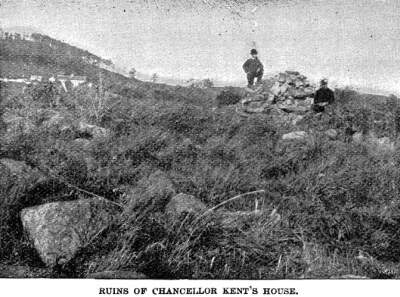 DOANSBURG
HILL. DOANSBURG
HILL.
On Doansburg Hill, east of the village, may be
seen the birth-place of Chancellor Kent, and a church is still
standing on the site that was occupied by Rev. Elisha Kent, the
Chancellor's grandfather, about 1740. Houses in which the Minute
Men held meetings at the beginning of the Revolutionary War are
pointed out, and many near descendants of officers in that war
are living in that vicinity. The storage reservoir, maintained
for the supply of Croton water to New York City, is a beautiful
sheet of water, surrounded by a macadamized driveway. Another
reservoir, known as "Sodam Dam," is now being constructed
one mile east of the village. The factory of the New York Condensed
Milk Company, on the east branch of the Croton River, receives
the milk of 8,000 cows, and produces daily 25,000 pounds of "Gail
Borden's Eagle Brand Condensed Milk," which, as is well known,
enjoys a world-wide reputation. The drives about Brewster are
easy and interesting, and the country around is noted for its
fine scenery. Resuming our way again, and passing the pretty little
village of Dykeman's, we come in sight of the extensive store-houses
of the National Ice Company at Ice Pond, the source of New York
City's principal ice supply. The pond—certainly worthy of
a more distinctive appellation—is a beautiful sheet of water
of crystal purity—and lies among the hills a little to the
east of the railroad track. It abounds with several varieties
of fish, and in Summer is a favorite resort of anglers. Two miles
further on is
TOWNERS.
Towners, delightfully situated in the midst of a fine
grazing country. Milk is naturally the chief product, but tobacco
is also cultivated quite successfully. Leaving Towners we speed
away over a level stretch for several miles, until we come to
PATTERSON.
Patterson, one of the most beautiful villages in Putnam
County, and an ideal spot to spend the Summer months. Farming
is the chief occupation, and so fertile is the soil and the conditions
of climate so favorable that bountiful crops are the rule. All
the surroundings of this place are picturesque, the combination
of hill and dale, stream and meadow, being very pleasant to the
eye. There are a number of handsome houses in the village and
several churches. The stock farm of Mr. E. A. Hayt is one of the
finest in this part of the State, and is visited by every one
who comes to Patterson. A quarry has recently been discovered
just back of the village, which yields a very fine quality of
colored marble, resembling closely in its markings and general
appearance Mexican onyx. Experts pronounce it the only deposit
of the kind in the United States, and it is expected that it will
very largely supply the place of fine foreign marbles in interior
decorations, etc. The discovery was made by the merest accident
a little over a year ago, by a party of prospectors, who were
endeavoring to locate a white marble quarry. A company has been
incorporated under the title of the Buch-Allen Marble Company,
and the work is being pushed with energy. A few minutes after
leaving Patterson, we enter Dutchess County, and arrive at
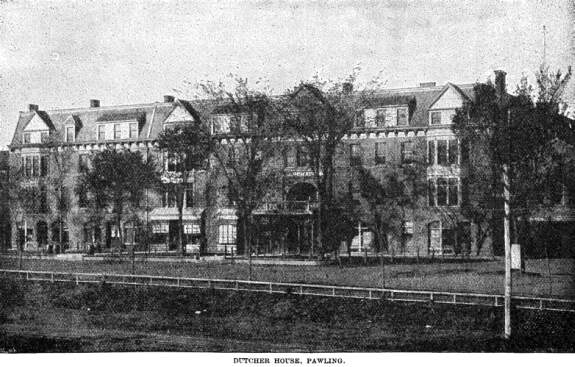 PAWLING. PAWLING.
Pawling, a charming place of about 1,200 population,
63 miles from New York, and especially fitted by Nature and art
for a first-class Summer resort. Situated some 700 feet above
the level of the sea, the air is remarkably pure, bracing and
delightful. The location is certainly as healthful as any in the
country, and, with the rapid transit of the Harlem Railroad, is
so near the great metropolis that business men may spend seven
or eight hours in the city between ordinary breakfast and dinner
hours, and breathe an absolutely pure and healthy atmosphere 14
hours out of 24. Mosquitoes and malaria are unknown here, Pawling
is indebted to the enterprise, liberality and public spirit of
John B. Dutcher, Esq., for one of the handsomest and best appointed
hotels to be found anywhere. In addition to the beautiful grounds
about the hotel, which include some eight or ten acres, and which
have 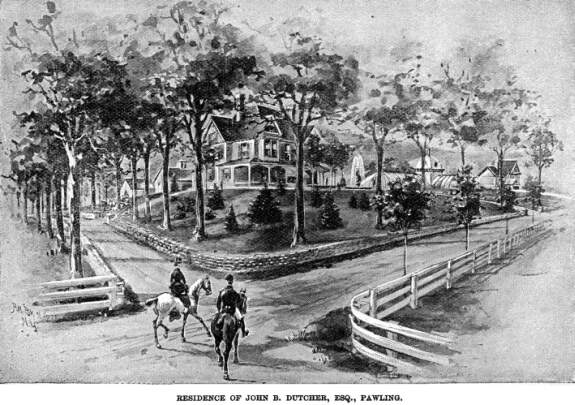 been laid
out with pleasing and artistic effect, a handsomely improved park
of 200 acres has been provided for the pleasure and comfort of
guests and visitors. Among the varied attractions of the park
is the beautiful been laid
out with pleasing and artistic effect, a handsomely improved park
of 200 acres has been provided for the pleasure and comfort of
guests and visitors. Among the varied attractions of the park
is the beautiful
GREEN MOUNTAIN LAKE.
Green Mountain Lake, well stocked with bass and
other choice fish; a beautiful evergreen mountain, with both walks
and a driveway to its summit, which commands a delightful view;
there is a club and boat-house of handsome design and ample proportions;
also, in the park an excellent half-mile driving course, which
is maintained in good condition during the season. Within a few
miles of Pawling there are several lakes. The nearest, about half
a mile from the hotel, is Green Mountain Lake, in Dutcher Park.
Whaley and Little Lakes, near by, are noted for their excellent
black bass, while Hammersley's Lake, a beautiful sheet of water
with shaded lawns encircling it, is especially popular with such
as are romantically inclined. From the summits of Mount Tom and
West Mountain, situated about a mile to the west of Pawling, a
view is presented of Catskill Mountains, 60 miles away.
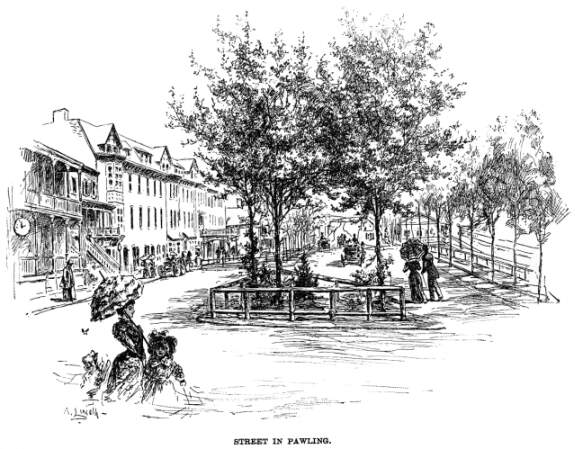 QUAKER
HILL. QUAKER
HILL.
To the east of the village-about three miles-is
Quaker Hill. Upon the summit is the Mizzentop Hotel, situated
at an actual elevation of 1, 300 feet above the sea, and commanding
some of the finest scenery found in the North. The healthfulness
of the place is unsurpassed, the sanitary arrangements perfect.
The air is cool, dry, invigorating and sleep-producing. The walks
and drives in the vicinity of Mizzentop are beautiful. Hammersley
Lake, within one and one half miles, furnishes excellent fishing.
The historical associations of Quaker Hill are full of interest.
Here Washington's headquarters were located during the Revolution,
and the house occupied by Washington and Lafayette remains but
slightly altered. The old Quaker Meeting House, erected in 1764,
is within walking distance of the hotel. Continuing our way, we
pass the little villages of South Dover and Dover Furnace, and
come to
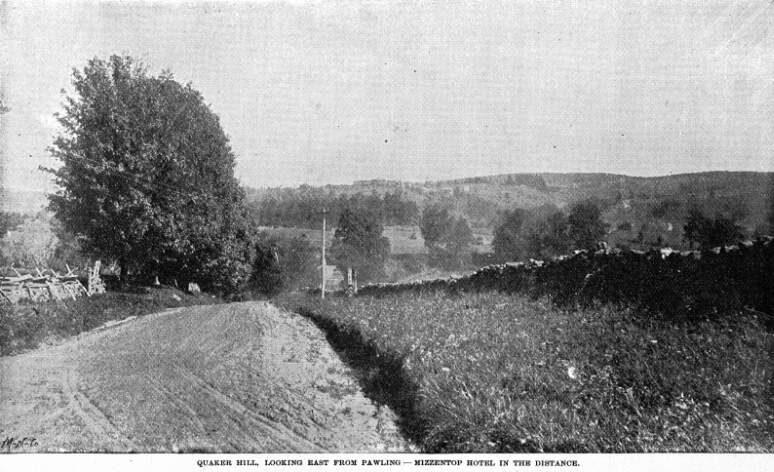
DOVER PLAINS.
Dover Plains, an interesting town of between 700 and
800 population, 76 miles from New York. There is no more picturesque
region within a few hours ride of New York City, by rail, than
the hill country of eastern Dutchess County lying along the borders
of Connecticut, and traversed by the Harlem Railroad. The two
ranges of lofty uplands known as Quaker Hill and Chestnut Ridge
may justly be ranked among the most healthful localities in the
State. Chestnut Ridge is about three miles in 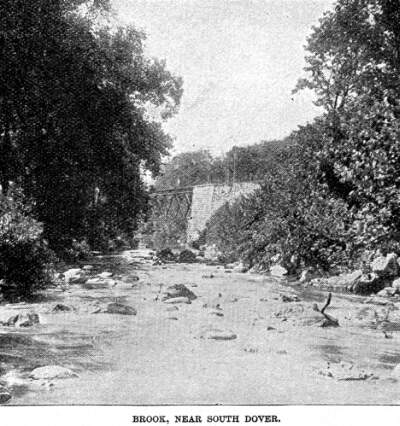 length, north and south, and forms a part
of the water-shed between the Hudson and Housatonic rivers. Its
mean altitude is about 1,100 feet above tide-water. It is a fragment
of the Blue Ridge branch of the Appalachian chain of mountains,
which is cleft by the Hudson at West Point, and, stretching away
northeastward, includes the lofty Taghkanick and Berkshire Hills
in Western Massachusetts and fraternizes with the Green Mountains
of Vermont and White Mountains of New Hampshire. The outlook from
the Ridge in all directions is magnificent. From one point there
is an uninterrupted view of the entire Catskill and Shawangunk
Mountain ranges, west of the Hudson, 80 miles in extent, from
the Highlands to the Helderbergh Hills in Albany County. The Ridge
itself is one of the richest grazing and fruit regions in the
State, nearly every acre being tillable land, and its healthfulness
is proverbial. The summit of the Ridge is reached by a picturesque
highway, three miles from Dover Plains Station. One of the points
of interest to strangers is the magnificent Stock Farm of Mr.
D. H. Sherman, the General Live Stock Agent of the Erie Road.
Some of the finest Holstein cattle in the country have been bred
by him. At Dover Plains are the famous "Wells" and the
"Old Stone Church," and both will repay a visit. The
small streams flowing from the western hills have worn deep ravines,
and in several places have formed beautiful cascades. About a
mile southwest of the village of Dover Plains a small stream flows
down the mountain in a succession of rapids, three to twelve feet
in height, and at the foot of each fall smooth, rounded holes,
called "The Wells," have been worn in the rocks to a
considerable depth. Above these, on the mountains, in a wooded
gorge with romantic and picturesque surroundings, is length, north and south, and forms a part
of the water-shed between the Hudson and Housatonic rivers. Its
mean altitude is about 1,100 feet above tide-water. It is a fragment
of the Blue Ridge branch of the Appalachian chain of mountains,
which is cleft by the Hudson at West Point, and, stretching away
northeastward, includes the lofty Taghkanick and Berkshire Hills
in Western Massachusetts and fraternizes with the Green Mountains
of Vermont and White Mountains of New Hampshire. The outlook from
the Ridge in all directions is magnificent. From one point there
is an uninterrupted view of the entire Catskill and Shawangunk
Mountain ranges, west of the Hudson, 80 miles in extent, from
the Highlands to the Helderbergh Hills in Albany County. The Ridge
itself is one of the richest grazing and fruit regions in the
State, nearly every acre being tillable land, and its healthfulness
is proverbial. The summit of the Ridge is reached by a picturesque
highway, three miles from Dover Plains Station. One of the points
of interest to strangers is the magnificent Stock Farm of Mr.
D. H. Sherman, the General Live Stock Agent of the Erie Road.
Some of the finest Holstein cattle in the country have been bred
by him. At Dover Plains are the famous "Wells" and the
"Old Stone Church," and both will repay a visit. The
small streams flowing from the western hills have worn deep ravines,
and in several places have formed beautiful cascades. About a
mile southwest of the village of Dover Plains a small stream flows
down the mountain in a succession of rapids, three to twelve feet
in height, and at the foot of each fall smooth, rounded holes,
called "The Wells," have been worn in the rocks to a
considerable depth. Above these, on the mountains, in a wooded
gorge with romantic and picturesque surroundings, is
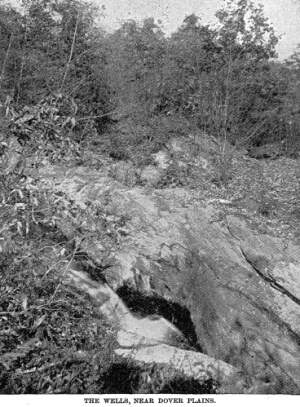 OLD STONE CHURCH. OLD STONE CHURCH.
The Old Stone Church. A small stream of water,
after leaving a little lake at the foot of the slope at Plymouth
Hill, glides in murmuring rapids nearly every foot of the way
until it reaches a point in the mountains west of Dover Plains
village, whence it descends in sparkling cascades to the level
fields below. This small stream, in its passage down this declivity
for ages, has worn for itself a remarkable channel through the
rocks. At a point toward the foot of the mountain it has wrought
an extensive Cavern, the entrance to it at the outlet of the stream
being in the form of a Gothic arch. The "Church" is
illuminated by a skylight formed by a fissure in the rocks above.
This light is pleasantly reflected upon the rocky sides of the
church, and reveals a fallen rock, which, from its position and
form, is called the "Pulpit." Out of the arched door
the brook—the patient architect of the church—flows
gently, and then leaps in cascades and rapids to the plains below.
From the apex of the roof the cavern gradually widens until, at
the base, the span of the arch is about 25 feet. At the farther
extremity of the church is a beautiful waterfall, over which a
staircase leads to extensive ledges of rocks at a height of 30
feet, forming commodious galleries overlooking the body of the
church. The massive sombre archway of the stone church cave, the
pulpit rock, the walls almost perfectly arched, and papered with
green moss and white lichen, the sound of falling water, and even
the spray behind the pulpit, like the sprinkling of holy incense—all
contribute to make it a church of Nature's own fashioning, literally
a little cathedral "not made with hands."
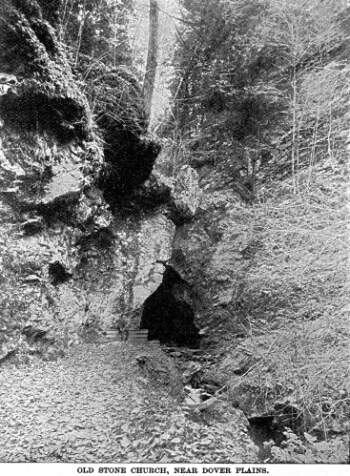 The Great Preacher
continues the same old service within its shadowed recesses that
was commenced ages ago, and which proceeds with the same solemn
stateliness whether men bear or forbear. Day and night, without
ceasing, vespers, mid-night mass and matins proceed. The deep-toned
organ peals as if it were the wind, and the chant of the choir
mingles its silvery tones as musically as the falling of water;
trumpet and cymbal and harp peal and fade and echo, and through
them tremble tones like the far-off voices of young men and maidens
singing. At sun-rise, through all the long Summer day, at twilight,
at evening, and louder as night deepens, the eternal service proceeds,
unwearied by the watchers of the day, by the changes of season,
by the lapse of years, or by the procession of centuries. The
Indian hushed and heard it; the white frontiersman heard it; and
it mingles just the same with silence or with the shriek of the
locomotive as we hurry on our journey, and in a few minutes find
ourselves at The Great Preacher
continues the same old service within its shadowed recesses that
was commenced ages ago, and which proceeds with the same solemn
stateliness whether men bear or forbear. Day and night, without
ceasing, vespers, mid-night mass and matins proceed. The deep-toned
organ peals as if it were the wind, and the chant of the choir
mingles its silvery tones as musically as the falling of water;
trumpet and cymbal and harp peal and fade and echo, and through
them tremble tones like the far-off voices of young men and maidens
singing. At sun-rise, through all the long Summer day, at twilight,
at evening, and louder as night deepens, the eternal service proceeds,
unwearied by the watchers of the day, by the changes of season,
by the lapse of years, or by the procession of centuries. The
Indian hushed and heard it; the white frontiersman heard it; and
it mingles just the same with silence or with the shriek of the
locomotive as we hurry on our journey, and in a few minutes find
ourselves at
WASSAIC.
Wassaic, a cozy little town of about 400 inhabitants,
81 miles from New York, that has surprised many tourists, familiar
with our own and foreign lands, with the imposing grandeur and
beauty of its scenery. A more delightful spot is rarely found.
There is a quaintness, too, about the place, its surroundings,
the numerous quiet nooks and shady retreats, that is sure to fascinate
the tourist, and afford the Summer resident continual enjoyment.
The New York Condensed Milk Company have another of their model
factories here, which gives employment to several hundred hands,
mostly recruited among the sons and daughters of neighboring farmers.
The process of condensing the milk and putting it into cans, ready
for the market, is intensely interesting, and requires some very
wonderful machinery. Three miles farther we come to
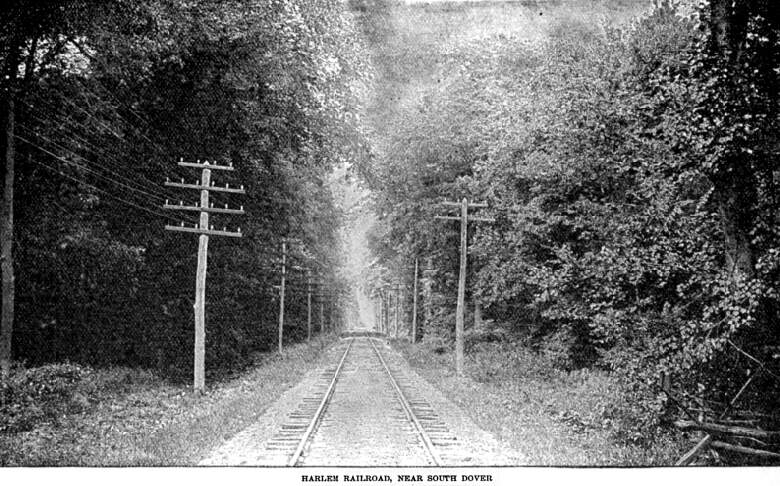
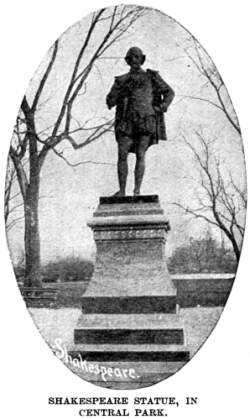 AMENIA. AMENIA.
Amenia, a handsome and thriving place, 84 miles from
New York, with a population of about 600. The valley here widens
into a bay of rolling meadow land, very much as the Hudson broadens
at Newburgh to one coming up the highlands.The Taghkanick Mountains
extend along the east border, and the Highlands belonging to the
Fishkill Range extend through the west part. No country affords
finer contrasts of mountain, hill, ravine, wood and cultivated
plain. All its approaches from the west are beside streams, through
gorges, up and down steep declivities as wild and varied as those
of far-famed Switzerland. The contrast between the fairness of
a clear Summer afternoon and a rugged thunder-storm in the night
is not greater than that of the fair fields of Lithgow and the
stern, dark mountains and fearful ruggedness of Deep Hollow.
Standing on an eminence, midway between the east and west ranges,
and occupying one of the finest points in the Harlem Valley, is
the Amenia Seminary, founded in 1835.
SHARON STREET.
Sharon Street, in the State of Connecticut, is
three and a half miles east of Amenia Station, or two and a half
miles from Sharon Station, with which it connects by stage. Many
Summer boarders are attracted to this spot by the rural loveliness
of the place, the "Street" being 200 feet wide and about
two miles long. Ranging along either side of this superb avenue
are grand old elms whose leafy branches intertwine o'erhead, forming
a natural arbor of rare beauty and proportions. Situated at an
elevation of 780 feet, it commands many and beautiful views across
to the Berkshire Hills, the intervening landscape being dotted
with thrifty farms and old residences 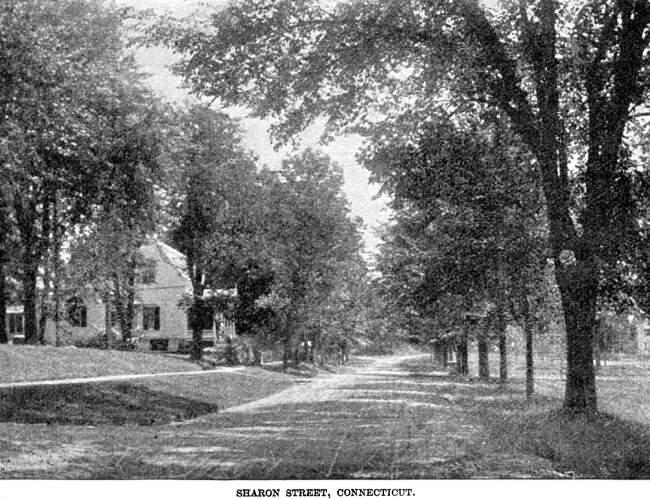 erected more than a hundred years ago,
but so well preserved that they scarcely show the wear of two
generations. The principal hotel is the Sharon Inn, conducted
by genial Solomon Kirby, but excellent accommodations are obtainable
at a score of other houses in the village. Indeed, the only business
prosecuted with any diligence during the season is that of keeping
Summer boarders. The drive across through the Sharon Valley is
one of the most delightful imaginable, and unfolds a succession
of charming views. The drives in this region are charming, and
in point of healthfulness and in freedom from all that is annoying,
nothing is left to be desired. Passing through Sharon Station
and Coleman's, we arrive at erected more than a hundred years ago,
but so well preserved that they scarcely show the wear of two
generations. The principal hotel is the Sharon Inn, conducted
by genial Solomon Kirby, but excellent accommodations are obtainable
at a score of other houses in the village. Indeed, the only business
prosecuted with any diligence during the season is that of keeping
Summer boarders. The drive across through the Sharon Valley is
one of the most delightful imaginable, and unfolds a succession
of charming views. The drives in this region are charming, and
in point of healthfulness and in freedom from all that is annoying,
nothing is left to be desired. Passing through Sharon Station
and Coleman's, we arrive at
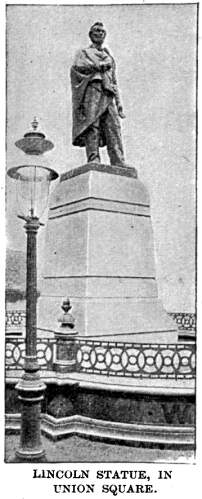 MILLERTON. MILLERTON.
Millerton, 92 miles front New York. Population about
700. At this point the Harlem Railroad connects with the Newburgh,
Dutchess & Connecticut Railroad for Millbrook, Matteawan and
Newburgh. Lakeville, the home of ex-Governor Holly, of Connecticut,
is a charming village, Two miles to the north of it is the residence
of William H. Barnum, Esq. Millerton is situated on high ground,
is exceedingly healthy, find enjoys cool nights through the warmest
weather. There are few places that have so many attractions within
a radius of from eight to ten miles. Twin Lakes are especially
grand, the largest or north lake, being about eight miles in circumference.
Near Millerton is the oldest iron mine, in the United States.
The ore from this mine was used in making cannon for the patriot
army of the Revolutionary War. Continuing on our way, we next
come to
MOUNT RIGA.
Mount Riga, 95 miles from New York, and the highest
point on the line of the Harlem Railroad, and which lies at an
elevation of 672 feet above tide level. The village has a population
of about 500. It lies in a valley three-fourths of a mile wide,
bounded on the east by the mountain front which it derives its
name, and on the west by a range of high hills running north about
four miles. The principal or most prominent hill, called "Cave
Hill," is directly opposite the village, and is covered by
a handsome forest growth. On a steep side of this hill is an extensive
cave, which, to a depth of 400 feet, contains apartments 50 feet
high. It has never been fully explored farther than 400 feet from
its mouth, owing to the narrowness of the passage at that point.
Three miles distant, on the very summit of Mount Riga, are two
large lakes, abounding with many varieties of choice fish. Two
miles north of the village, Webotuck Brook has its source; running
south through the valley, and augmented by numerous small tributaries,
it becomes quite a stream of pure spring water, and affords good
trout fishing. Four miles from the village, on Riga Range, is
the highest point in the State of Connecticut. The next point
we reach is
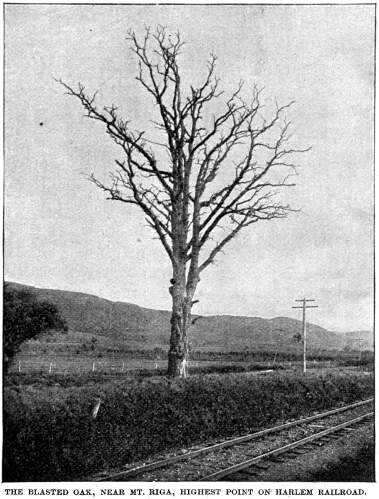 BOSTON CORNERS. BOSTON CORNERS.
Boston Corners, an interesting town in Columbia County,
99 miles from New York, and the junction of the Harlem Railroad
with the Philadelphia, Reading & New England and the New York
& Massachusetts Railroads. Boston Corners will long be remembered
as the place where the famous prize fight between John Morrissey
and Yankee Sullivan occurred. At the point where the "ring
was pitched" one can step from the State of New York into
Connecticut or Massachusetts. Resuming our way, a ride of five
miles brings us to
COPAKE.
Copake, 104 miles from New York, and with a population
of about 400. Here are extensive iron works, and about two miles
east of the station are the famous Bash-Bish Falls, a favorite
resort for picnic parties, and, as to scenery, is one of the finest
points of observation between New York and Montreal. The waters
come dashing down the mountain side in a reckless sort of glee,
splashing and leaping from crag to crag, while here and there,
in a sunlit opening of the grand old forest, is the tasteful residence
of some admirer of the picturesque in Nature. The Gorge, the Rock
Cliffs, the Eagle's Nest and Sunset Cliff are well worthy of an
afternoon's visit. Five miles from Copake (or Copake Iron Works,
as the station is now called) is
MOUNT WASHINGTON.
Mount Washington, the southwestern township of
Berkshire County, Massachusetts. It includes a plateau of several
miles in extent, with an elevation of 2,000 feet, and is bordered
by mountain tops which rise several hundred feet higher—Mount
Everett, which has an altitude of nearly 2,700 feet, being the
highest peak. Many of the surrounding mountain-tops are easily
reached by delightful drives or rambles, and afford extensive
views of the lower country. Looking east from Mount Everett, the
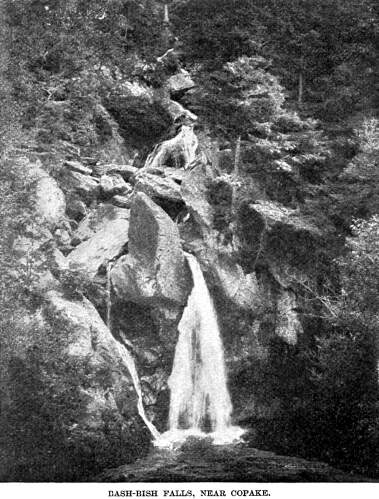 Housatonic Valley,
including Great Barrington, Sheffield, Egremont and other villages,
is in plain view; and to the west from Mount Alandar, the Valley
of the Hudson extending to the Catskill Mountains, 35 miles away.
Owing to its elevation this place is always cool and breezy, and
the absence of manufacturing of any kind renders the air and water
pure. The scenery is varied and picturesque in the extreme, and
the seeker after pleasure finds an endless variety of attractions—waterfalls,
gorges, ravines, lakes, trout streams and excellent roads, which
are well kept. The drives are indeed delightful, and include the
following places of interest: Sunset Rock, Prospect Rock, Mount
Fray, Bare Rock Falls; Sage's Ravine, with its numerous cascades;
Bash-Bish Falls, with its hotel and, by a half mile walk at the
terminus of a drive, the summit of Mount Everett. No place in
Berkshire County is so favorably situated as a Summer resort as
Mount Washington, and the hotels and boarding houses are well
tilled during the Summer months. The South Berkshire Mountain
Club, an association organized for the purpose of securing to
a limited number of families a sociable, enjoyable and inexpensive
Summer home among the most picturesque and healthful surroundings
to be found in New England, has selected as a site the Taconic
Woodlands, the westerly portion of the celebrated Sky Farm, in
the town of Mount Washington. The Woodlands are 1,700 feet above
tide-water, and are reached by a drive of three miles over a charmingly
romantic road from Copake Station. The historic Sky Farm Cottage
has been selected to serve the present requirements of a club
house and restaurant. Table board and accommodations for a limited
number of lodgers can be lead at reasonable rates. Returning to
Copake, and resuming our way, a ride of a few miles brings us
to Housatonic Valley,
including Great Barrington, Sheffield, Egremont and other villages,
is in plain view; and to the west from Mount Alandar, the Valley
of the Hudson extending to the Catskill Mountains, 35 miles away.
Owing to its elevation this place is always cool and breezy, and
the absence of manufacturing of any kind renders the air and water
pure. The scenery is varied and picturesque in the extreme, and
the seeker after pleasure finds an endless variety of attractions—waterfalls,
gorges, ravines, lakes, trout streams and excellent roads, which
are well kept. The drives are indeed delightful, and include the
following places of interest: Sunset Rock, Prospect Rock, Mount
Fray, Bare Rock Falls; Sage's Ravine, with its numerous cascades;
Bash-Bish Falls, with its hotel and, by a half mile walk at the
terminus of a drive, the summit of Mount Everett. No place in
Berkshire County is so favorably situated as a Summer resort as
Mount Washington, and the hotels and boarding houses are well
tilled during the Summer months. The South Berkshire Mountain
Club, an association organized for the purpose of securing to
a limited number of families a sociable, enjoyable and inexpensive
Summer home among the most picturesque and healthful surroundings
to be found in New England, has selected as a site the Taconic
Woodlands, the westerly portion of the celebrated Sky Farm, in
the town of Mount Washington. The Woodlands are 1,700 feet above
tide-water, and are reached by a drive of three miles over a charmingly
romantic road from Copake Station. The historic Sky Farm Cottage
has been selected to serve the present requirements of a club
house and restaurant. Table board and accommodations for a limited
number of lodgers can be lead at reasonable rates. Returning to
Copake, and resuming our way, a ride of a few miles brings us
to
HILLSDALE.
Hillsdale, a lovely spot, appropriately named, 108
miles from New York, and nine miles from Great Barrington, which
is also a popular center for Summer boarders, lying, as it does,
in a lap of hills, surrounded by rare beauty. Many persons who
choose Great Barrington for their Summer home come via Harlem
Railroad to Hillsdale, so as to enjoy the delightful drive of
nine miles across the country. The turbulence in Hillsdale for
three-fourths of a century after its first settlement by civilized
people, who were composed of different nationalities, has prevented
any historic record being kept of them. In 1620 the King of England
granted to a New England company all the territory in America
between the 40th and 48th degree of north latitude, with an unlimited
boundary on the west, which, of course, embraced what is now the
town of Hillsdale. Subsequently, the government of Holland conveyed
to a Dutch company the territory in America between the Chesapeake
Bay and the Connecticut River, the town of Hillsdale being embraced
in the conveyance. In pursuance of the English grant, Robert Noble
emigrated from Westfield to Hillsdale, and was the first white
settler in the town. He, with his associates, procured the Indian
title to land five miles square. They built a fort on what is
now the land of Leonard Johnson, at which one life was lost in
the conflict under land titles, and many arrests were made
under both the authorities of New York and Massachusetts,
and men were long imprisoned, both at Albany and Springfield.
Such is the early history of Hillsdale. One poet has sung that
"A competence is all that a man can enjoy," while another
has sung, "Be it ever so humble, there is no place like home."
Hillsdale possesses the means for many a happy home. There is
that about this vicinity which is especially welcome and enjoyable
to those who love the beauties of Nature combined with a pure
and invigorating atmosphere.
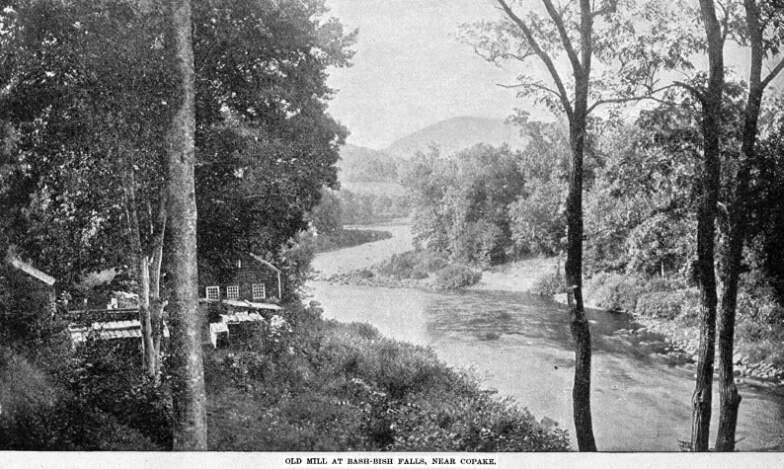
Continuing our journey, and passing through Craryville, Martindale
and Philmont, with its manufactories and knitting-mills, we come
upon one of the finest views in Hudson Valley. Well cultivated
farms, with their pleasant farmhouses, slope away toward the river,
and the hills covered with flocks and the valleys with corn, seem
only little patches of various colors reaching away to the blue
Catskills. Passing the little town of Ghent, with its peaceful
population of about 500, we come to
CHATHAM.
Chatham, the terminus of the Harlem Railroad, 127 miles
from New York. Population of about 3,000. This is a busy little
railroad center, where connections are made with the Boston &
Albany Railroad for all points west; and for Pittsfield, North
Adams, Springfield and Boston, to the east. Connections are also
made with the Lebanon Springs Railroad for Lebanon Springs and
other points north. Chatham and its vicinity present many attractions
to those who, choosing pleasant homes for the Summer, desire to
seek rest and quiet from the busy turmoil of the city, and yet
remain within easy reach of railroads, telegraph, post-office,
etc. With its fine hotels, numerous private boarding-houses, all
pleasantly located, accommodations can be furnished for a large
number of guests, and at moderate prices. Or, should a more rural
life be preferred during the warmer (lays of Summer, numberless
pleasant farm houses may be found within 10 or 15 minutes' drive
from the village, where all the pleasures of "life on the
farm" may be enjoyed.
From the eminences in and about Chatham beautiful views may
be had of the surrounding country, with the Catskill Mountains
and the grand old Hudson in the distance. These, together with
the pleasant drives, good roads, and pure, bracing air, add much
toward making it a most desirable locality in which to take up
a residence for the Summer months. The lovers of good fishing
can also find numerous trout streams within a radius of a dozen
miles, which are prolific with specimens of that gamy species
of the fish family which delights the heart of the fisherman.
The lakes of Queechy , Kinderhook and Copake furnish ample fishing
grounds for bass, pickerel, perch and white fish.
Stories Page | Contents Page
|







